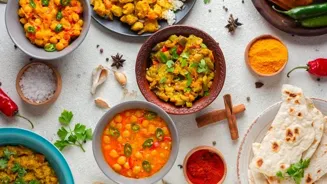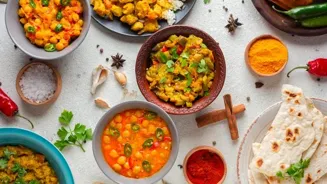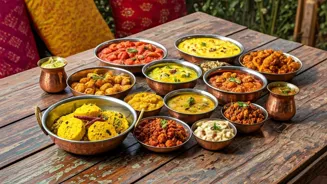Unveiling the Delectable World of Indian Chutneys: A Culinary Adventure Beckons! Discover the magic of chutneys!
India, a land renowned for its vibrant culture and flavorful cuisine, boasts a culinary landscape
as diverse as its geography. And at the heart of this rich tapestry of tastes lies the humble yet indispensable chutney.
More than just a condiment, chutney is an integral part of the Indian dining experience, adding a burst of freshness, spice, tang, or sweetness to any meal.
From the bustling streets of Mumbai to the serene backwaters of Kerala, each region has its own unique chutney recipes, passed down through generations.
This article will delve into the fascinating world of Indian chutneys, exploring their different varieties, ingredients, and their delightful uses. So, prepare your taste buds for a flavorful journey as we unravel the secrets of these culinary gems!
Indian chutneys: diverse types offer unique tastes & textures, a culinary adventure
The world of Indian chutneys is wonderfully diverse, categorized largely by their key ingredients and preparation methods. Fresh chutneys, often made with herbs like coriander or mint, offer a vibrant, refreshing taste.
Cooked chutneys, on the other hand, typically involve simmering fruits or vegetables with spices, resulting in a deeper, more complex flavor profile. Dry chutneys, usually made with roasted lentils, spices, and desiccated coconut, provide a crunchy, savory element.
The most common types include mint-coriander chutney (hari chutney), tomato chutney, coconut chutney, mango chutney, and tamarind chutney (imli chutney). Each chutney boasts a unique taste and texture, and the possibilities are endless!
Exploring these different types is like embarking on a mini culinary adventure, with each taste revealing a new facet of Indian cuisine.
Indian chutneys: diverse ingredients create unique flavors
The ingredients that go into making Indian chutneys are as varied as the country itself. A key ingredient is, of course, the base, which could be anything from fresh herbs like coriander, mint, or curry leaves to fruits like mango, tamarind, or tomatoes.
Vegetables like onion, garlic, ginger, and green chilies are used to add depth of flavor. Spices such as cumin, coriander, mustard seeds, and fenugreek contribute warmth and complexity. A touch of sweetness is often added using sugar or jaggery, while a squeeze of lemon or lime provides acidity.
Sometimes, nuts like peanuts or cashews are added for texture and richness. The combinations are virtually limitless, limited only by the cook's imagination and the availability of ingredients.
This flexibility allows for regional variations and personal preferences, making each chutney a unique expression of culinary creativity.
Various chutney types enhance Indian cuisine with unique flavors
Each chutney type has a special place in Indian cuisine because of its amazing tastes, colors, and smell. The cool green mint and coriander chutney provides newness and sharpness, and is used for sandwiches or with tandoori snacks.
The sweet and sour mango chutney is a delight to have in the summer, and makes the best pairing with parathas and rice. From the South side, coconut chutney provides a nutty flavor which goes well with dosas, idlis, and vadas.
The fiery tomato chutney gives warmth and richness, making meals more special. These are the types of chutneys available and because of its flexible ingredients, there are many ways to add to the texture.
Chutneys are versatile condiments that enhance meals and offer health benefits
Chutneys are incredibly versatile and can be used in a myriad of ways to enhance meals. They serve as dips for snacks like samosas, pakoras, and kebabs. They can be spread on sandwiches and wraps to add a burst of flavour.
Chutneys can also be used as condiments to accompany main courses like rice, dal, and roti. A dollop of chutney can elevate a simple meal into a flavourful feast. In addition to their culinary uses, chutneys also offer several health benefits.
Fresh herb chutneys are packed with vitamins and antioxidants. Spices like ginger and garlic have anti-inflammatory properties. Tamarind chutney can aid digestion.
By incorporating chutneys into your diet, you can not only enhance the flavour of your meals but also boost your overall health and well-being.
Making chutney at home offers customization and variety with easy recipes
Making chutney at home is easy and rewarding, allowing you to customize the flavors to your liking. There are countless recipes available online and in cookbooks, each offering a unique twist on traditional chutneys.
Whether you prefer a spicy green chutney, a sweet mango chutney, or a tangy tamarind chutney, you can easily find a recipe that suits your taste. All you need are fresh ingredients, a blender or food processor, and a little patience.
Once you start experimenting with homemade chutneys, you'll be amazed at the variety of flavors you can create. And the best part is that you can adjust the ingredients to suit your dietary needs and preferences.
For example, you can reduce the amount of sugar if you're watching your sugar intake or add more chilies if you like it spicy.
Indian chutneys elevate Indian cuisine with diversity, health benefits, and flavor
In conclusion, Indian chutneys are more than just condiments; they are a cultural treasure that adds richness and complexity to Indian cuisine. Their diversity, versatility, and health benefits make them an indispensable part of the Indian dining experience.
Whether you're a seasoned cook or a beginner, exploring the world of Indian chutneys is a journey worth taking. So, go ahead, experiment with different recipes, and discover your favorite chutney.
You might just find that it's the perfect finishing touch that takes your meals from ordinary to extraordinary. The only limit is your imagination and that is how Indian deliciousness is made!
AI Generated Content. Glance/InMobi shall have no liability for the content








